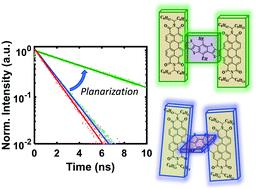当前位置:
X-MOL 学术
›
Chem. Sci.
›
论文详情
Our official English website, www.x-mol.net, welcomes your feedback! (Note: you will need to create a separate account there.)
Photophysical implications of ring fusion, linker length, and twisting angle in a series of perylenediimide–thienoacene dimers
Chemical Science ( IF 8.4 ) Pub Date : 2020-07-01 , DOI: 10.1039/d0sc02862b Ariel A. Leonard 1, 2, 3, 4 , Martín A. Mosquera 1, 2, 3, 4 , Leighton O. Jones 1, 2, 3, 4 , Zhengxu Cai 5, 6, 7, 8, 9 , Thomas J. Fauvell 1, 2, 3, 4 , Matthew S. Kirschner 1, 2, 3, 4 , David J. Gosztola 4, 10, 11 , George C. Schatz 1, 2, 3, 4 , Richard D. Schaller 1, 2, 3, 4, 10 , Luping Yu 4, 12, 13, 14 , Lin X. Chen 1, 2, 3, 4, 15
Chemical Science ( IF 8.4 ) Pub Date : 2020-07-01 , DOI: 10.1039/d0sc02862b Ariel A. Leonard 1, 2, 3, 4 , Martín A. Mosquera 1, 2, 3, 4 , Leighton O. Jones 1, 2, 3, 4 , Zhengxu Cai 5, 6, 7, 8, 9 , Thomas J. Fauvell 1, 2, 3, 4 , Matthew S. Kirschner 1, 2, 3, 4 , David J. Gosztola 4, 10, 11 , George C. Schatz 1, 2, 3, 4 , Richard D. Schaller 1, 2, 3, 4, 10 , Luping Yu 4, 12, 13, 14 , Lin X. Chen 1, 2, 3, 4, 15
Affiliation

|
Perylenediimide (PDI) derivatives have been widely studied as electron acceptor alternatives to fullerenes in organic photovoltaics (OPVs) because of their tunable absorption in the visible range, inexpensive synthesis, and photochemical stability. A common motif for improving device efficiency involves joining multiple PDIs together through electron-rich linkers to form a twisted acceptor–donor–acceptor molecule. Molecular features such as ring fusion are further employed to modify the structure locally and in films. These synthetic efforts have greatly enhanced OPV device efficiencies, however it remains unclear how the increasingly elaborate structural modifications affect the photophysical processes integral to efficient photon-to-charge conversion. Here we carry out a systematic study of a series of PDI dimers with thienoacene linkers in which the twist angle, linker length, and degree of ring fusion are varied to investigate the effects of these structural features on the molecular excited states and exciton recombination dynamics. Spectroscopic characterization of the dimers suggest that ring fusion causes greater coupling between the donor and acceptor components and greatly enhances the lifetime of a thienoacene to PDI charge transfer state. The lifetime of this CT state also correlates well with the linker–PDI dihedral angle, with smaller dihedral angle resulting in longer lifetime. DFT and two-photon absorption TDDFT calculations were developed in-house to model the ground state and excited transitions, providing theoretical insight into the reasons for the observed photophysical properties and identifying the charge transfer state in the excited state absorption spectra. These results highlight how the longevity of the excited state species, important for the efficient conversion of excitons to free carriers in OPV devices, can be chemically tuned by controlling ring fusion and by using steric effects to control the relative orientations of the molecular fragments. The results provide a successful rationalization of the behavior of solar cells involving these acceptor molecules.
中文翻译:

一系列of二酰亚胺-硫杂并苯二聚体中环融合,接头长度和扭转角的光物理影响
ylene二酰亚胺(PDI)衍生物由于在可见光范围内的可调吸收,廉价的合成以及光化学稳定性,已被广泛研究为有机光伏(OPV)中富勒烯的电子受体替代物。提高设备效率的常见主题涉及通过富电子连接子将多个PDI连接在一起以形成扭曲的受体-施主-受体分子。进一步采用分子特征,例如环融合,以局部和在膜中修饰结构。这些合成的努力极大地提高了OPV器件的效率,但是仍然不清楚的是,越来越精细的结构修饰如何影响光子过程的效率,而光子过程是有效的光子-电荷转换所必需的。在这里,我们对一系列具有硫杂并并苯并苯并二氢呋喃的PDI二聚体进行了系统研究,其中扭转角,接头长度和环稠合度均发生变化,以研究这些结构特征对分子激发态和激子复合动力学的影响。二聚体的光谱表征表明,环稠合引起供体和受体组分之间的更大偶联,并大大延长了噻吩并苯到PDI电荷转移状态的寿命。此CT状态的寿命也与连接子-PDI二面角密切相关,较小的二面角导致更长的寿命。内部开发了DFT和两光子吸收TDDFT计算,以模拟基态和激发跃迁,为观察到的光物理性质的原因提供理论见解,并在激发态吸收光谱中识别电荷转移态。这些结果强调了如何通过控制环融合和利用空间效应控制分子片段的相对方向来化学调节对激发态物质有效地活化OPV装置中的激子有效转化为游离载子至关重要的寿命。结果提供了涉及这些受体分子的太阳能电池的行为的成功合理化。通过控制环稠合和利用空间效应来控制分子片段的相对取向,可以对C 1 -C 1进行化学调节。结果提供了涉及这些受体分子的太阳能电池的行为的成功合理化。通过控制环稠合和利用空间效应来控制分子片段的相对取向,可以对C 1 -C 1进行化学调节。结果提供了涉及这些受体分子的太阳能电池的行为的成功合理化。
更新日期:2020-07-15
中文翻译:

一系列of二酰亚胺-硫杂并苯二聚体中环融合,接头长度和扭转角的光物理影响
ylene二酰亚胺(PDI)衍生物由于在可见光范围内的可调吸收,廉价的合成以及光化学稳定性,已被广泛研究为有机光伏(OPV)中富勒烯的电子受体替代物。提高设备效率的常见主题涉及通过富电子连接子将多个PDI连接在一起以形成扭曲的受体-施主-受体分子。进一步采用分子特征,例如环融合,以局部和在膜中修饰结构。这些合成的努力极大地提高了OPV器件的效率,但是仍然不清楚的是,越来越精细的结构修饰如何影响光子过程的效率,而光子过程是有效的光子-电荷转换所必需的。在这里,我们对一系列具有硫杂并并苯并苯并二氢呋喃的PDI二聚体进行了系统研究,其中扭转角,接头长度和环稠合度均发生变化,以研究这些结构特征对分子激发态和激子复合动力学的影响。二聚体的光谱表征表明,环稠合引起供体和受体组分之间的更大偶联,并大大延长了噻吩并苯到PDI电荷转移状态的寿命。此CT状态的寿命也与连接子-PDI二面角密切相关,较小的二面角导致更长的寿命。内部开发了DFT和两光子吸收TDDFT计算,以模拟基态和激发跃迁,为观察到的光物理性质的原因提供理论见解,并在激发态吸收光谱中识别电荷转移态。这些结果强调了如何通过控制环融合和利用空间效应控制分子片段的相对方向来化学调节对激发态物质有效地活化OPV装置中的激子有效转化为游离载子至关重要的寿命。结果提供了涉及这些受体分子的太阳能电池的行为的成功合理化。通过控制环稠合和利用空间效应来控制分子片段的相对取向,可以对C 1 -C 1进行化学调节。结果提供了涉及这些受体分子的太阳能电池的行为的成功合理化。通过控制环稠合和利用空间效应来控制分子片段的相对取向,可以对C 1 -C 1进行化学调节。结果提供了涉及这些受体分子的太阳能电池的行为的成功合理化。



























 京公网安备 11010802027423号
京公网安备 11010802027423号